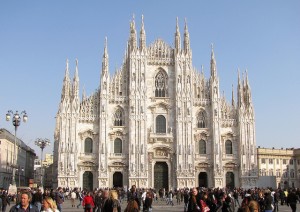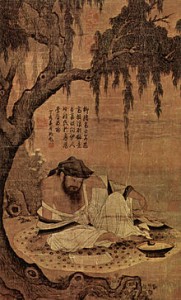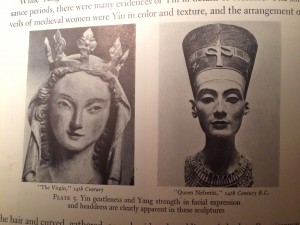Today, I will finally continue my series documenting the information in Belle Northrup’s 1936 article, “Art and Personality in Clothing Selection.”
Last post, I talked about how she saw yin and yang generally, and the examples she gave of yin and yang in nature. This time, I will share her examples of yin and yang in architecture, art, period dress, and music.
Pagodas, the “cusped arches of Moorish doorways,” the decorative walls and balustrades of the Alhambra, and the Taj Mahal’s marble carvings and delicate mosaics are all yin. So are “prim little green-shuttered cottages of New England.”
Sorry, nothing found.
(Sources: 1, 2, 3, 4, 5)
Early Doric temples, the “massive columns of the Great Hall at Karnak in Egypt,” the masonry arches of Romanesque or Norman buildings, and the “white-pillared Georgian mansions of the [US] South” are all yang. Grain elevators of the prairies and modern industrial buildings lacking ornamentation are also yang.
Sorry, nothing found.
(Sources: 1, 2, 3, 4, 5, 6)
Gothic cathedrals combine both yin and yang. Their “towering structure and vaulted heights” represent their yang, and their “slender pinnacles and lacelike carving” are yin.

(Source)
In art, Botticelli’s fragile figures, da Vinci’s subtle and tender faces, and Marie Laurencin’s pale, child-like women are all yin. The use of color gives a general impression of gentleness and delicacy.
Sorry, nothing found.
(Sources: 1, 2, 3)
Tintoretto, Rubens, Hals, and many modern artists use pigment in a very yang way.
Sorry, nothing found.
(Sources: 1, 2, 3)
Painting in the Sung period blended yin with yang.

(Source)
In early Greek sculpture, we see them in contrast to one another. An Ancient Greek dancer in bas relief is yin. “Juno, Hera of Samoa” is yang. Stone as a medium is essentially yang.
Sorry, nothing found.
(Sources: 1, 2)
Egyptian queens and medieval women wore yang costumes, regal and dignified. The portals of Chartres have carved kings and queens of Judah in austere yang forms. Smaller carvings, such as this 14th-century “Virgin,” show this dignified costume in a yin way. The statue of Nefertiti is dressed in a yang way.
Sorry, nothing found.
(Sources: 1, 2, 3)
Medieval women’s soft veils were yin in color texture, and so were Renaissance women’s hairstyles and the embroidered necklines of the late Renaissance. Yin began to predominate in the 19th century. Fichus, lace, ribbons, ruffled sleeves, bonnets, and “the short, full skirts of Marie Antoinette’s time gave to women more piquancy and delicacy than was possible in the days of Charlemagne.”
Sorry, nothing found.
(Sources: 1, 2, 3)
Puritan dress was yang. Loyalists dressed in a yin way akin to the fashions in England and France.
Sorry, nothing found.
(Sources: 1, 2)
In music, Debussy’s delicate strangeness is yin (listen) and the mighty sweep of a Beethoven movement is yang (listen). Chopin, Grieg, and MacDowell are yin, and Bach, Brahms, and Wagner are yang.
Graceful yachts are yin. Sturdy tugboats are yang. The Sheraton settee is yin, while the low-slung sofas of Northrup’s period are yang.
Sorry, nothing found.
(Sources: 1, 2, 3, 4)
Next, I will cover yin and yang in women, featuring 1930s celebrity examples.

Chiara
February 14, 2015 at 10:17 pmOh, fantastic post! I really enjoy your blog. Thinking about the different ways artists use pigment is a very interesting idea. Does Northrup say anything about where she places the Impressionists?
One comment- I think that ‘Royalist’ painting is far later then Puritan, it’s a Reynolds, I think, so late 18th century.
However, this portrait is maybe a good contemporary Yin contrast to 17th century Puritan styles : http://www.allartclassic.com/pictures_zoom.php?p_number=40&p=&number=DYS031
stylesyntax
February 14, 2015 at 11:03 pmNorthrup wrote “Royalist,” but it’s probably better to use “Loyalist,” since it’s specific to the American Revolutionary War/Colonial era. The late 1700s time period is correct. I switched it to “loyalist” in the post to make it clearer, and changed the painting, because the one I had was actually an English woman.
Everything Northrup mentions I put in the post. But I would certainly say that the Impressionists would be very, very yin (probably why I hate them:)). The idea of “painting light” is about as yin as you can get. Debussy is an Impressionist composer, so I think that whole entire movement is very yin.
Chiara
February 16, 2015 at 10:00 amHa! You know, I’d completely forgotten this might have been referring to the American War for Independence, and thought it was the English Civil War…
stylesyntax
February 16, 2015 at 2:53 pmHaha, no word on whether Roundheads were yin or yang!